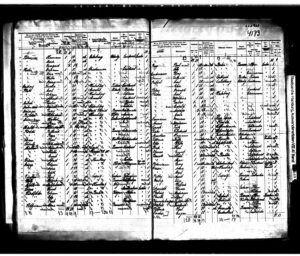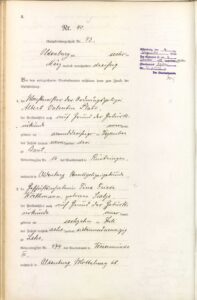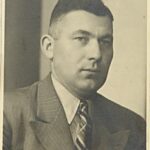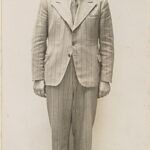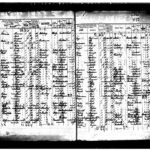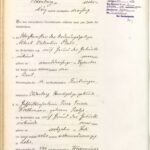Introduction
Post Status
This page is currently a working draft and will undergo further updates.
Facts Sheet
Name: Albert Plate
Birth: 31.12.1903 in Rüstringen (Wilhelmshaven)
Death: 4.10.1944
Function: Deputy Commander of Sonderkommando Kulmhof (1942 – 1943)
Agency: Stapo Litzmannstadt
Rank: Obwm (01.02.1934), Rev.Obwm. (01.09.1935), Krim.Ob.Ass, Krim.Sekr. (01.06.1941), Krim.Ob.Sekr. (01.10.1942)
Memberships: NSDAP (01.05.1933 #2867578)
Awards: KVK II m.Schw. (1942?)
Education: Primary school (eight-year)
Profession: Farmer, police officer
Family: married (06.03.1930), 1 child (guardian)



Quotes
Curriculum Vitae
Albert Plate was born on December 31, 1903, in Rüstringen (Wilhelmshaven). His parents were the ship’s carpenter Johann Plate (born October 13, 1873) and Anna Dreyer (born February 12, 1875). He had eight siblings. Plate attended elementary schools in Hamburg (from age 6 to 14) and in Oldenburg. In 1915, Plate volunteered for land service and was worked with a farmer in Borbeck (Essen).
During the winters of 1919 and 1920, Plate attended an agricultural school in Oldenburg, but struggled to find work as a farmer in post-war Germany. On December 20, 1923, Plate emigrated to Pernambuco, Brazil, with the hope to establish himself as a farmer. He was, however, unable to gain a professional foothold there and returned to Germany in November 1925.
On February 1, 1926, he joined the Schutzpolizei in Oldenburg. Within a year, he was promoted to Unterwachtmeister of the Schutzpolizei and served with the so-called Revierhundertschaft in field service. On March 6, 1930, he married Tina Siebje, who brought her daughter L. into the marriage.
Plate joined the NSDAP on May 1, 1933, under membership number 2867578. He was promoted to Oberwachtmeister of the Schutzpolizei (February 1, 1934) and later to Revieroberwachtmeister of the Schutzpolizei (September 1, 1935).
On February 1, 1938, Plate was transferred to the Geheime Staatspolizei in Aachen as provisional Krim.-Oberassistent. After attending the leadership school in Berlin/Charlottenburg, he was appointed Krim.-Oberassistent on December 1, 1938. On June 1, 1941, he was promoted to Kriminal-Sekretär and on 1 October, 1942, to Kriminal-Obersekretär.1
During the Poland campaign, Plate was assigned to Einsatzkommando 2 of Einsatzgruppe III and later integrated into the Staatspolizeistelle Litzmannstadt. His daughter was also employed at the Stapo Litzmannstadt, as stenotypist.2
With the National Socialists’ colonial ambitions for Africa, Plate volunteered for service in the colonies. In February 1941, he completed a colonial training course at the leadership school of the Security Police in Berlin Charlottenburg. 3 The Geheime Staatspolizei in Litzmannstadt nominated Plate in January 1942 for the War Merit Cross 2nd Class with Swords.4
Instead of being deployed to Africa, at the end of 1941, the SS-Sonderkommando leader Herbert Lange recruited Plate to the extermination camp Kulmhof. Both men likely knew each other already from their time at the Stapo Aachen. After the departure of SS-Obersturmführer Herbert Otto in early 1942, Plate assumed the position of acting camp commander until the camp’s dissolution. In this role, Plate was a key figure in the extermination of Jews at Kulmhof.
Plate supervised operations both in the so called castle or mansion in Kulmhof and the body disposal in the Rzuchów forest. The police officer Kurt Moebius characterized him as “the ‘big boss’ in Kulmhof, acting with a real lust for power”. Plate was directly involved in the murder and personally shot members of the Jewish work commando selected for execution.
After the extermination camp was closed, Plate was drafted for military service in the 7th SS Volunteer Mountain Division “Prinz Eugen”. Like the other former members of the SS-Sonderkommando Kulmhof, he was deployed in the field gendarmerie. On October 4, 1944, Plate was seriously injured while his company attempted to blow up the bridge over the Timok in Vratarnica and subsequently shot himself.
Documents
